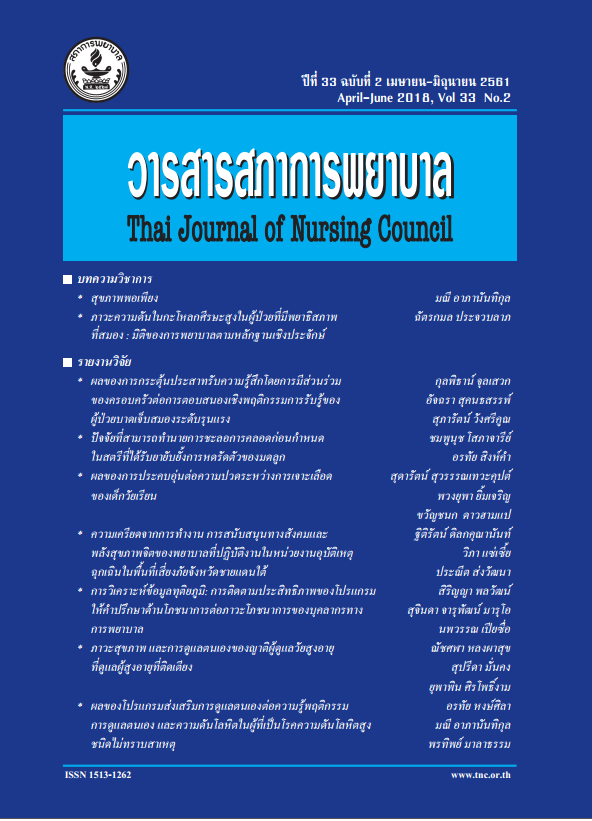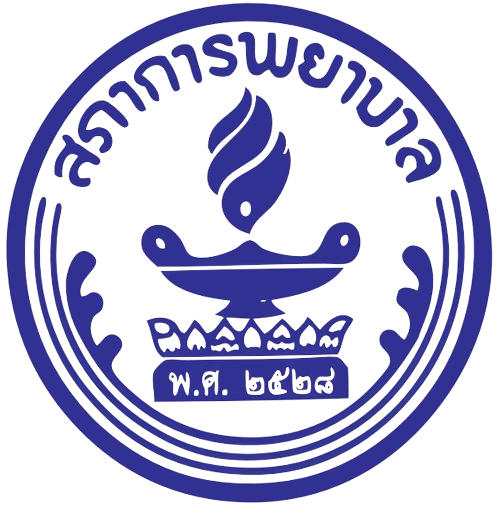Effects of Warm Compresses on School-Age Children’s Perception of Pain during Venipuncture
Keywords:
warm compress, pain during venipuncture, school-age childrenAbstract
Abstract
Objective: To compare school-age children’s perception of pain during venipuncture
with and without warm compresses.
Design: Two-group experimental research with a pre-test and a post-test.
Procedure: The sample was school-age children (6-15 years) treated in the paediatric
surgical ward at Siriraj Hospital. The children, who were required to have venipuncture
prior to their scheduled surgery, displayed no disease-induced pain. They were selected
based on the inclusion criteria and, by means of simple random sampling (lot drawing),
divided into an experimental group (n = 40) and a control group (n = 40). Each
experimental group member received a warm compress above the venipuncture site and
on the occiput from before to after the venipuncture, a total of 4-5 minutes. The control
group, on the other hand, underwent standard venipuncture. The venipuncture was carried
out solely by the researcher’s assistant. Data were collected using a self-report scale
for facial expression of pain, which was completed before and after the venipuncture,
and a form measuring each participant’s satisfaction with the pain-reducing warm compress.
The data were analysed using descriptive statistics and Mann Whitney U test.
Results: The experimental group’s score on the level of pain after the experiment
(mean = 2.45, SD = 2.81) was lower than that of the control group (mean 3.57, SD =
2.87). The difference between the two groups was statistically signifcant (Z = -2.338,
p = .019).
Recommendations: It is suggested that nurses adopt warm compresses to reduce
school-age children’s pain during venipuncture.
Downloads
References
1. Wall PD, Melzack R. Psychology in action. In: Coon D, Mitterer OJ, editors. Introduction to psychology gateways to mind and behavior. 20thed. New York;2008. p. 145.
2. Benzon HT, Rathmell JP, Wu CL, Turk DC, Argoff CE. Acute pain management in children. In: Benzon TH, editor. Raj’s practical management of pain.Philadelphia: Mosby Elsevier; 2014. p. 543.
3. Jolly H, Simpson K, Bishop B, Hunter H, Newell C, Denney D, et al. Impact of warm compresses on local
injection-site reactions with self-administered glatiramer acetate. J Neurosci Nurs 2008;40(4):232-9.69
4. Shelat AM. 7 Tips to reduce the pain of injections. Healthcentral. [internet]. [updated 2017 Aug 26; cited 2018 July 5]. Available from: URL:https://www.healthcentral.com/slideshow/7-tips-toreduce-the-pain-of-injections#slide=1
5. Baxter GD, Basford JR. Overview of other electrophysical and thermal agent. In: Sluka KA, editor. Mechanisms and management of pain for the physical therapist. Section II: Physical therapy pain management. U.S.A.: IASP Press;2009. p. 194.
6. The University of Chicago Comer Children’s hospital. Warmth ‘gives babies pain relief’ during vaccination [internet]. [updated 2012 Apr 11; cited 2018 July 5]. Available from: URL:https://www.biospace.com/article/warmth-gives-babies-pain-relief-duringvaccination-university-of-chicago-study-/.
7. Shenaran S. Physiology of heat. In: Tasubamon T, editor. Treatment of heat cold light sound 1 themotherapy 1. 1st ed. Changmai: Physiotherapy department; 1997.p. 8-11. (In Thai)
8. Short S, Pace G, Birnbaum C. Nonpharmacologic Techniques to Assist in Pediatric Pain Management. Pediatr Emerg Care 2017;18(4):256-60.
9. Yoo H, Kim S, Hur HK, Kim HS. The effects of an animation distraction intervention on pain response of preschool children during venipuncture. Appl Nurs Res: ANR 2011;24(2):94-100.
10. Lenhardt R, Seybold T, Kimberger O, Stoiser B, Sessler DI. Local warming and insertion of peripheral venous cannulas: Single blinded prospective randomised controlled trial and single blinded randomised crossover trial. BMJ 2002;325(7361): 409-10.
11. Shenaran S. Physiology of heat. In: Tasubamon T, editor. Treatment of heat cold light sound1 themotherapy 1. 1sted. Changmai: Physiotherapy department;2540. p.9 (In Thai)
12. Chakaew L. The effect of teaching program for nurse ability in pain management of post operative patient. Songkla: Prince of Songkla;2004. (In Thai)
13. Chauyjitt W. The effect of refrigerated alcohol compression in receiving venepuncture [dissertation]. Songkla: Prince of Songkla Univ.; 1992. (In Thai)
14. Cohen J. Statistical power analysis for the behavioral sciences. Hillsdale Lawrence Erlbaum Associates: New Jersey; 1988.
15. Stinson J, Yamada J, Kavanagh T, Gill N, Stevens B. Systematic review of the psychometric properties and feasibility of self-report pain measures for use in clinical trials in children and adolescents. Pain 2006;
125(1–2):143–57.
16. Phumpradub P. The effect of heel warming by mung bean sock on pain response in newborn receiving heel prick [dissertation]. Bangkok: Chulalongkorn Univ.; 2013. (In Thai)
17. Barçin C, Kurşaklioğlu H, Köse S, Amasyali B, Işik E. Resistant radial artery spasm during coronary angiography via radial approach responded to local warm compress. Anadolu Kardiyol Derg 2010;10(1): 90-1.
18. Yoo H, Kim S, Hur HK, Kim HS. The effects of an animation distraction intervention on pain response of preschool children during venipuncture. Appl Nurs Res: ANR 2011;24(2):94-100.








